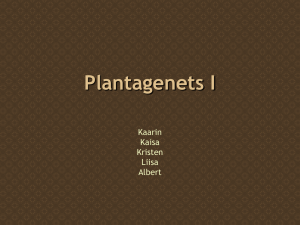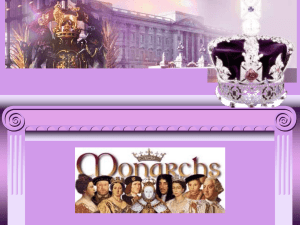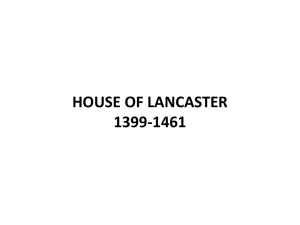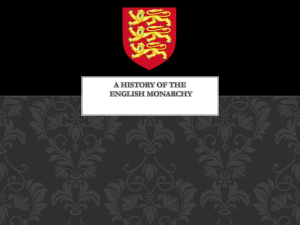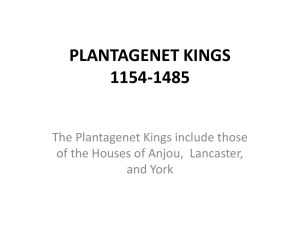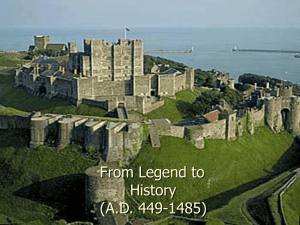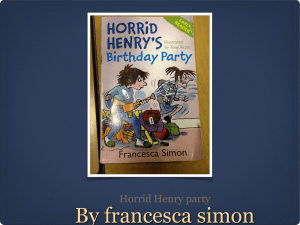St. Swithun's Incumbents: A Historical List (1220-1671)
advertisement
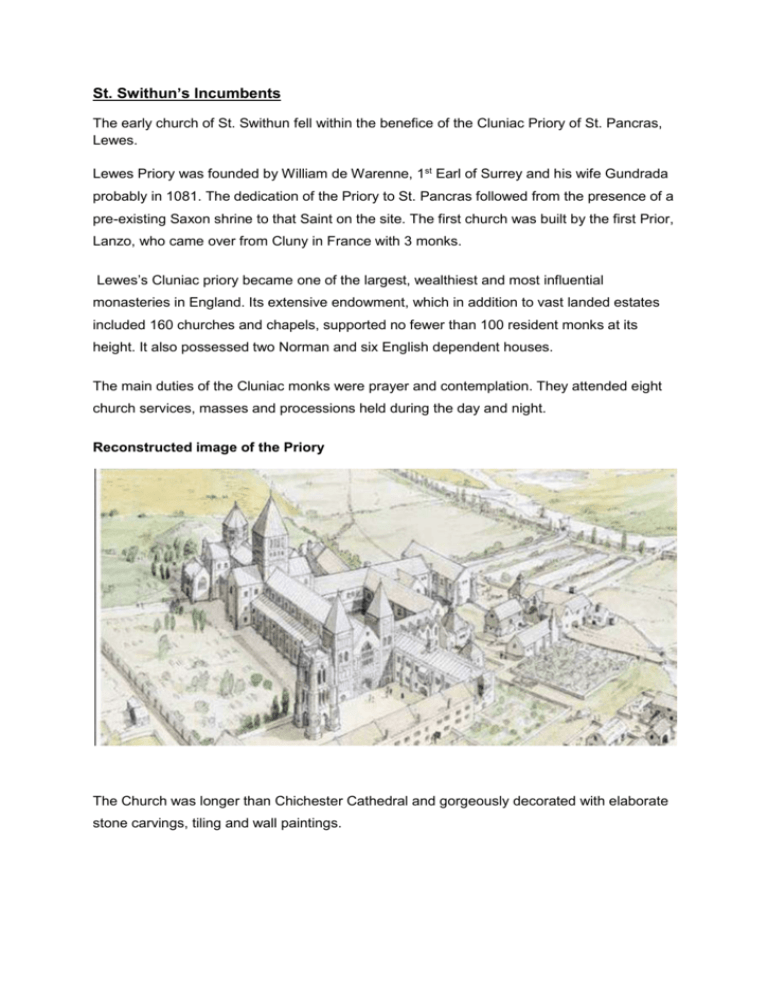
St. Swithun’s Incumbents The early church of St. Swithun fell within the benefice of the Cluniac Priory of St. Pancras, Lewes. Lewes Priory was founded by William de Warenne, 1st Earl of Surrey and his wife Gundrada probably in 1081. The dedication of the Priory to St. Pancras followed from the presence of a pre-existing Saxon shrine to that Saint on the site. The first church was built by the first Prior, Lanzo, who came over from Cluny in France with 3 monks. Lewes’s Cluniac priory became one of the largest, wealthiest and most influential monasteries in England. Its extensive endowment, which in addition to vast landed estates included 160 churches and chapels, supported no fewer than 100 resident monks at its height. It also possessed two Norman and six English dependent houses. The main duties of the Cluniac monks were prayer and contemplation. They attended eight church services, masses and processions held during the day and night. Reconstructed image of the Priory The Church was longer than Chichester Cathedral and gorgeously decorated with elaborate stone carvings, tiling and wall paintings. The Cluniac order gave great importance to worship and beauty. It was renowned for long and elaborate services, singing and ornate decorations. The monks spent much of the day and night attending services or processing through the Priory. The priory was surrendered to the Crown on 16 November 1537 and its destruction carried out at the direction of Henry VIII’s secretary, Thomas Cromwell. Lewes Priory Ruins Incumbents of St. Swithun’s Soon after the Priory of St. Pancras was established at Lewes; in 1078 Alured who was “pincerna” or Cup bearer to Robert the first Count of Mortain, gave the church of East Grinstead, and half a hide of land belonging to it at Imberhorne, towards the support of Lewes Priory. This is the first mention of such a building in East Grinstead. This grant was confirmed by William Count of Moretain, half-brother to William the Conqueror, by a charter circa 1108. In 1352 the living was exchanged by the Prior and Convent of Lewes for the church at Burton, but the living continued in the gift of the Prior until 1554, when Anne of Cleves held the living. She lived for a time at Lewes and had been divorced by Henry VIII in 1540; the right of presentation probably being given to her at the time of the confiscation of ecclesiastic property in 1545. She died in 1557 and the privilege of presentation passed to various branches of the Sackville family of Knowle. Name Richard Peter Ray Date of Incumbancy 1220 1241 Alard Robert de Wynton 1285 1296 William de Astania 1304 Thomas Peter Johannes de Wynton 1306 1327 1328 Raymond Pellegrini 1331 Anibaldus (Cardinal Bishop of Tusculum) 1331 Points of Interest Henry III on throne 1st Baron’s War - 1264 Battle of Lewes Peter Ray mentioned in the muniments of St. Mary Magdalen College, Oxford Edward I (Longshanks) on throne Got into trouble for fishing in a pond at Imberhorne without permission from the Prior Also Rector of West Grinstead and Prebend of Lincoln, Wells and St. David’s Edward II on throne Edward II abdicated 1327 John de Warrenne (7th Earl of Surrey) brought an action against Adam de Winton, monk and John, “persona ecclie de Estgrenestede”. Johannes exchanged the living of Atherton with Raymond Pellegrini. Edward III was 14 yrs old when he acceded to the throne in 1327. His mother Isabella of France was regent until 1330. [Ref. Papal Registers: Raimund Pelegrini, Canon of London, papal nuncio. Faculty to use papal letters touching the Roman church and the papal camera in Ireland.] Holder of several benefices and high offices. 1335 Anglo-Scottish dispute, the French support Scotland. Anibaldus credited with achieving the truce. [Ref: Papal Registers - To the Cardinals Anibaldus and Stephen, papal nuncios. Touching the reformation of peace between the kings of France and England, and reciting all that has been done to that end from the time of Benedict XII. In accordance with which they are to carry out their mission.] 1337 Outbreak of the Hundred Year War Richard de Bannebury 1346 Richard de Derby 1350 William de Longburgh Simon de Bredon John Kirkeby Richard Markwyk 1351 1351 1360 1381 Richard Stoneherst 1387 Thomas Ferryng 1395 John Bakere 1397 Ricardus atte Estcote 1410 Michael Preston Robert Burgh John Mankyn 1411 1414 1417 Adam Newyle 1417 John Benet 1423 William Lane 1430 Geoffrey Medewe Robert Blowere 1438 1438 John Cook 1463 Summoned by John de Warrenne, Earl of Surrey for breaking into Worth Park and hunting therein. 1346 Battle of Crecy 1348 - 1350 The Black Death killed a third of England’s population 1363 English becomes the official court language 1377 Richard II accedes to the throne aged 10 yrs 1381 Peasants Revolt England ruled by various regency councils. 1389 Richard II gains his majority, takes control. Summoned by Prior of Lewes for breaking with force of arms into a close belonging to said Prior. 1397-1399 Lords Appellant rebellion 1399 Henry Bolingbroke (son or John of Gaunt) deposes Richard II 1400 Henry IV assumes the throne. [Henry IV's son, Humphrey Duke of Gloucester’s descendants include Elizabeth Bowes-Lyon , Queen consort of George VI and mother of Elizabeth II and the Queen's current daughters-inlaw, Camilla, Duchess of Cornwall and Sophie, Countess of Wessex]. 1413 Henry IV dies succeeded by Henry V 1415 Battle of Agincourt Exchanged living with Robert Burgh. 1417 English adopted as the language of record within government Exchanged living with John Benet, Vicar of Wadhurst. 1422 Henry V dies aged 35 years 1422 Henry VI was just 9 months old when he acceded to the throne - he was the youngest ever monarch. Also titular King of France through his mother Catherine of Valois. England was governed by regency until 1437. 1431 Henry VI crowned King of France at Notre Dame, Paris. William Lane exchanges living with Geoffrey Medewe, Diocese of Lincoln 1437 Henry Vi assumes the reigns of office 1445 Henry VI marries Margaret of Anjou 1453 following the loss of Bordeaux Henry has a mental breakdown. 1455 -1487 War of the Roses 1454 Duke of York declared Protector of the Realm 1461 Henry VI deposed by Edward of York 1470 Henry VI restored to throne 1471 Battle of Tewksbury - Edward IV wins back crown and Henry VI dies in custody. John Brether 1478 Edward Prymer William Breton, LLD 1528 1528 Robert Best 1552-1553 William Devonshire 1554 Richard Burnopp 1563 1483 Edward IV dies. Edward V declared King but was never crowned; he was believed to have been murdered [Princes in the Tower] 1483 – 1485 Richard III on throne 1485 Richard III defeated at Battle of BosworthHenry Tudor claims the throne 1486 Henry VII marries Elizabeth of York [see brass wall monument to Dame Katherine Grey lady-in-waiting to Elizabeth Woodville (Queen to Edward IV) and to Elizabeth of York (Henry VII's Queen) . 1509 Henry VIII accedes to the throne 1521 Pope declares Henry “Defender of the Faith” 1533 Start of English Reformation 1537 Lewes Priory surrendered to the Crown 1540 Henry marries Anne of Cleves and divorces her six months later. 1547 Henry VIII dies and 9 year old Edward VI accedes to throne. England is ruled by Regency Council. During Edward’s reign Protestantism was said to have been established. 1549 Services are compulsorily said in English and 1st Common Prayer book introduced by Cranmer. 1553 Edward VI dies leaving Lady Jane Grey as his protestant heir but thirteen days later she is deposed by Queen Mary I, in whose reign Catholicism was re-instated. Robert Best was deposed because he was married, but he was later re-installed. Appointed by Anne of Cleves 1556 Three Protestant Martyrs of East Grinstead burnt at the stake for holding to their faith. [Ref. Foxe’s Book of Martyrs, Volume II] 1558 Mary succeeded by Elizabeth I who restores the Protestant faith which quickly evolves into the Church of England The first Vicar presented to the living by the Sackville family. Star Chamber proceedings state that this Vicar being "a very lewd and wicked p'son altogether swarvinge from his profession nor having the fear of God before his eies " did, at Lewes Sessions, falsely swear that James Pickas, gent., arrested him while at the communion table, to the great disturbance of the communicants. It was proved that such an event never took place and that Richard Burnopp was "a common reporter of manifest untruths and dayly disturber of his quiet neighb™ and an intermeddler in other men's causes," having procured them to spend over £500 in useless law suits. What the Star Chamber did to him is not stated. John Walwyn, M.A. 1598 Edward Topsell, M.A. 1610 Alan Carr 1615 James Inians 1637 Richard Goff 1643 Samuel Pretty 1645 Stephen Watkins George Blundell 1645 1647 Robert Crayford 1657 Christopher Snell 1658-1662 John Saywell, D.D. 1671 Former Rector of Wisborough Green, Arundel, Withyam and Fletching. Later Vicar of Heathfield. 1603 King James VI of Scotland proclaimed as James 1 of England. 1605 Gunpowder Plot 1607 Jamestown, Virginia, North America founded Author of considerable repute. His chief works were "The Historie of Foure-footed Beastes " and "The Historie of Serpents." He was perpetual curate of St. Botolph, Aldersgate. He held several country livings, including East Grinstead, held at the same time. 1611 King James’ Bible published Owned several parcels of land in East Grinstead and Lingfield. 1625 James I succeeded by Charles I Buried in 1642 at East Grinstead 1642 English Civil War began Ejected because he was proved to be “a common haunter of Tavernes and Alehouses, a common swearer of bloudy oathes and singer of baudy songs and often drunke and keepeth company with Papists and scandalous persons.” The living was sequestered from Goff to Pretty who does not seem to have been in Holy Orders. He was ordered to pay a fifth part of the profits of the Vicarage to his predecessor's wife, and neglecting to do so an action was brought against him. While it was in progress the Committee of Plundered Ministers sequestered the Vicarage from Pretty and returned him " into the County of Wiltshire, from where he had been driven by the King's forces." Puritan, resigned 1647 A Puritan but he later conformed. 1649 Charles I executed A Puritan. 1653 Removed from office as usher in the free grammar school in Cambridge. [Ref: The Crayford Affair: Transcript of the Testimony of the Master and Four Senior Fellows of Gonville and Caius College] A Puritan 1658 Death of Oliver Cromwell 1660 Charles II restored to the monarchy 1662 Book of Common Prayer published 1662 Snell ejected 1665 Great Plague, 1666 Great Fire of London 1683 St. Swithun’s struck by lightning, 1684 Church tower re-built. 1685 James II, the last Catholic monarch, accedes to the throne. 1688 deposed and succeeded by Mary II and William III of Orange. John Staples, M.A. 1689 George Garnett, M.A. Thomas James. M. A. Henry Woodward, M.A. 1732 1746 1757 Charles Whitehead, M.A. 1764 Stileman Bostock, M.A. Richard Taylor, M.A. 1792 1811 Christopher Nevill, M.A. 1835 John Netherton Harward, M.A. 1848 John Peat, M.A. 1863 Douglas Yeoman Blakiston, M.A W. W. Youard, M.A. 1871 1908 E. L. Macassey, D.D. 1924 G. Golding-Bird, D.D. 1925 H.C.F. Copsey John Roger Brown, A.K.C. Clive Everett-Allen, A.K.C. 1955 1978 1998 1694 Queen Mary aged 32 years died of smallpox. William III continued to reign until 1702. 1702 Queen Anne succeeds to the throne. 1707 the Act of Union (creates the Kingdom of Great Britain). 1714 Queen Anne dies, succeeded by George I (of Hanover). Cabinet government introduced. 1727 George I dies, succeeded by George II. 1732 John Staples dies of smallpox Died 1746 1760 George II dies; succeeded by George III 1763 Henry Woodard died 1775-1783 American War of Independence 1785 St. Swithun’s church tower falls, destroying church. 1789 St. Swithun’s church rebuilt. 1803-1815 Napoleonic Wars 1815 Battle of Waterloo 1820 George III died, succeeded by George IV 1835 Richard Taylor dies 1820-1822 Played first class cricket for Cambridge University Cricket Club. While English chaplain at Lisbon in 1830 collected funds for the erection of a sarcophagus over the grave of Henry Fielding, the novelist. 1847 Nevill dies 1853-1856 Crimean War – two of Harward’s sons fought with distinction during this period. 1863 Harward died Formerly Master of Sevenoaks Grammar School. Gained some repute as an author translating the Sapphic Odes of Horace and also published a poem entitled “The Fair Evanthe” in which he described that which is “beautiful, graceful, excellent and holy in women”. He died in 1871 and is buried at Chevening near Sevenoaks. 1871 the Great Gale with 50 estimated dead 1910 George V on the throne 1914-1918 World War I 1919 Rood Screen erected 1924 Ramsay McDonald becomes first Labour Prime Minister 1936 Edward VIII accedes to the throne abdicates Dec 1936 - George VI on throne 1939-1945 World War II 1952 Queen Elizabeth II accedes to the throne Prebendary of Chichester Prebendary of Chichester Prebendary of Chichester References: Please note, this document has been compiled using secondary resources. Lewes Priory Trust: The Priory of St. Pancras Lewes www.sussexhistory.co.uk: The History of East Ginstead – its places, institutions, people and events Wikipedia British History Online: Calendar of Papal Registers Vol. I M.J. Leppard: St. Swithun’s Church East Grinstead, The East Grinstead Martyrs (published by the East Grinstead Society ) Caroline Metcalfe: The Katherine Grey Monument (St. Swithun’s Church, East Grinstead) ‘The Crayford Affair’ 1653: Testimony of the Master and Four Senior Fellows of Gonville and Caius College St. Swithun’s Church, East Grinstead historic documentation Lynn Ellis 28 February 2014
